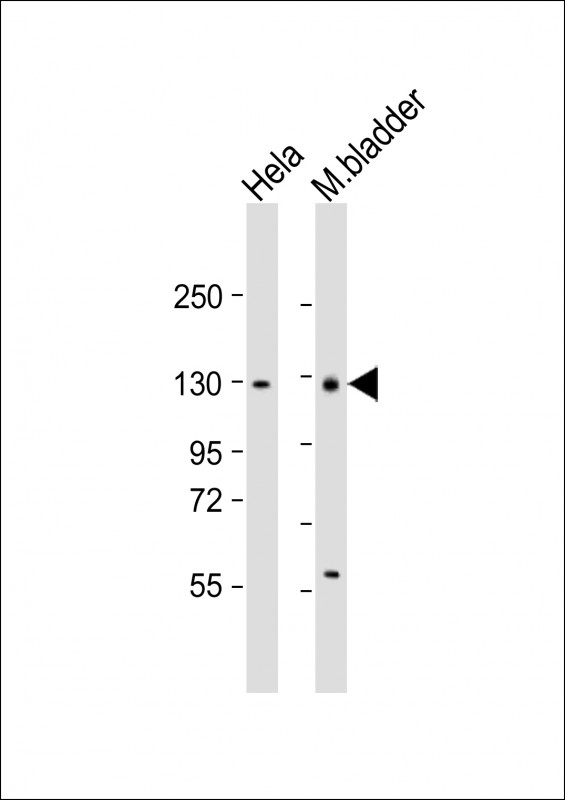Mouse Enpp1 Antibody (N-term)
Affinity Purified Rabbit Polyclonal Antibody (Pab)
- 产品详情
- 实验流程
- 背景知识
Application
| WB, E |
|---|---|
| Primary Accession | P06802 |
| Reactivity | Human, Mouse |
| Host | Rabbit |
| Clonality | Polyclonal |
| Isotype | Rabbit IgG |
| Calculated MW | 103176 Da |
| Antigen Region | 29-57 aa |
| Gene ID | 18605 |
|---|---|
| Other Names | Ectonucleotide pyrophosphatase/phosphodiesterase family member 1, E-NPP 1, Lymphocyte antigen 41, Ly-41, Phosphodiesterase I/nucleotide pyrophosphatase 1, Plasma-cell membrane glycoprotein PC-1, Alkaline phosphodiesterase I, Nucleotide pyrophosphatase, NPPase, Enpp1, Npps, Pc1, Pdnp1 |
| Target/Specificity | This Mouse Enpp1 antibody is generated from rabbits immunized with a KLH conjugated synthetic peptide between 29-57 amino acids from the N-terminal region of mouse Enpp1. |
| Dilution | WB~~1:1000 E~~Use at an assay dependent concentration. |
| Format | Purified polyclonal antibody supplied in PBS with 0.09% (W/V) sodium azide. This antibody is purified through a protein A column, followed by peptide affinity purification. |
| Storage | Maintain refrigerated at 2-8°C for up to 2 weeks. For long term storage store at -20°C in small aliquots to prevent freeze-thaw cycles. |
| Precautions | Mouse Enpp1 Antibody (N-term) is for research use only and not for use in diagnostic or therapeutic procedures. |
| Name | Enpp1 {ECO:0000303|PubMed:23027977, ECO:0000312|MGI:MGI:97370} |
|---|---|
| Function | Nucleotide pyrophosphatase that generates diphosphate (PPi) and functions in bone mineralization and soft tissue calcification by regulating pyrophosphate levels (PubMed:10352096, PubMed:11004006, PubMed:12082181, PubMed:22510396, PubMed:25260930, PubMed:9662402). PPi inhibits bone mineralization and soft tissue calcification by binding to nascent hydroxyapatite crystals, thereby preventing further growth of these crystals (PubMed:10352096, PubMed:11004006, PubMed:12082181, PubMed:19419305, PubMed:22510396, PubMed:25260930, PubMed:25479107, PubMed:26910915, PubMed:30111653, PubMed:35147247, PubMed:9662402). Preferentially hydrolyzes ATP, but can also hydrolyze other nucleoside 5' triphosphates such as GTP, CTP and UTP to their corresponding monophosphates with release of pyrophosphate, as well as diadenosine polyphosphates, and also 3',5'-cAMP to AMP (PubMed:11027689, PubMed:1647027, PubMed:23027977, PubMed:8223581). May also be involved in the regulation of the availability of nucleotide sugars in the endoplasmic reticulum and Golgi, and the regulation of purinergic signaling (PubMed:1647027). Inhibits ectopic joint calcification and maintains articular chondrocytes by repressing hedgehog signaling; it is however unclear whether hedgehog inhibition is direct or indirect (PubMed:30111653). Appears to modulate insulin sensitivity (By similarity). Also involved in melanogenesis (By similarity). Also able to hydrolyze 2',3'-cGAMP (cyclic GMP-AMP), a second messenger that activates TMEM173/STING and triggers type-I interferon production (PubMed:25344812). 2',3'-cGAMP degradation takes place in the lumen or extracellular space, and not in the cytosol where it is produced; the role of 2',3'-cGAMP hydrolysis is therefore unclear (By similarity). Not able to hydrolyze the 2',3'-cGAMP linkage isomer 3',3'-cGAMP (By similarity). |
| Cellular Location | [Ectonucleotide pyrophosphatase/phosphodiesterase family member 1]: Cell membrane; Single-pass type II membrane protein. Basolateral cell membrane; Single-pass type II membrane protein. Note=Targeted to the basolateral membrane in polarized epithelial cells and in hepatocytes, and to matrix vesicles in osteoblasts. |
| Tissue Location | Selectively expressed on the surface of antibody- secreting cells (PubMed:3104326). Expressed in osteocytes and osteoclasts (PubMed:25260930). |
For Research Use Only. Not For Use In Diagnostic Procedures.
Provided below are standard protocols that you may find useful for product applications.
BACKGROUND
Involved primarily in ATP hydrolysis at the plasma membrane. Plays a role in regulating pyrophosphate levels, and functions in bone mineralization and soft tissue calcification. In vitro, has a broad specificity, hydrolyzing other nucleoside 5' triphosphates such as GTP, CTP, TTP and UTP to their corresponding monophosphates with release of pyrophosphate and diadenosine polyphosphates, and also 3',5'-cAMP to AMP. May also be involved in the regulation of the availability of nucleotide sugars in the endoplasmic reticulum and Golgi, and the regulation of purinergic signaling. Appears to modulate insulin sensitivity (By similarity).
终于等到您。ABCEPTA(百远生物)抗体产品。
点击下方“我要评价 ”按钮提交您的反馈信息,您的反馈和评价是我们最宝贵的财富之一,
我们将在1-3个工作日内处理您的反馈信息。
如有疑问,联系:0512-88856768 tech-china@abcepta.com.























 癌症的基本特征包括细胞增殖、血管生成、迁移、凋亡逃避机制和细胞永生等。找到癌症发生过程中这些通路的关键标记物和对应的抗体用于检测至关重要。
癌症的基本特征包括细胞增殖、血管生成、迁移、凋亡逃避机制和细胞永生等。找到癌症发生过程中这些通路的关键标记物和对应的抗体用于检测至关重要。 为您推荐一个泛素化位点预测神器——泛素化分析工具,可以为您的蛋白的泛素化位点作出预测和评分。
为您推荐一个泛素化位点预测神器——泛素化分析工具,可以为您的蛋白的泛素化位点作出预测和评分。 细胞自噬受体图形绘图工具为你的蛋白的细胞受体结合位点作出预测和评分,识别结合到自噬通路中的蛋白是非常重要的,便于让我们理解自噬在正常生理、病理过程中的作用,如发育、细胞分化、神经退化性疾病、压力条件下、感染和癌症。
细胞自噬受体图形绘图工具为你的蛋白的细胞受体结合位点作出预测和评分,识别结合到自噬通路中的蛋白是非常重要的,便于让我们理解自噬在正常生理、病理过程中的作用,如发育、细胞分化、神经退化性疾病、压力条件下、感染和癌症。






